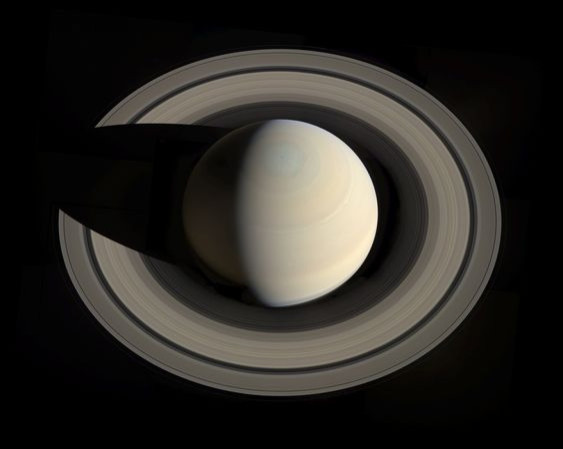The Week In Science: Saturn Snapshot, Tilted Solar System And A 'Law Of Urination'

This week in science, we found a skull that could rewrite the story of human evolution, found that chicken soup really does help for a cold (but steam doesn’t), and were reassured by some scientists that it’s fine to pet our cats. But there’s still a wealth of other science happenings this week, so here’s a roundup of what we missed:
The Los Angeles Times will no longer run letters from people that claim human-driven global warming is a hoax. Letters editor Paul Thornton says that “Saying ‘there's no sign humans have caused climate change’ is not stating an opinion, it's asserting a factual inaccuracy.” [LA Times]
There’s a new asteroid to worry about: 2013 TV135. The quarter mile-wide rock was recently discovered by researchers at the Crimean Astrophysical Observatory, and calculations show it’ll be making a close pass near Earth in 2032. However, at the moment, preliminary estimates only give the rock a 1-in-63,000 chance of striking us. Those are pretty good odds, and it’s likely that they’ll get even better with more observations. [Slate]
A computer programmer from Croatia stitched together 36 shots of the planet Saturn taken by the Cassini spacecraft. The result is one of the most breath-taking photos of the ringed planet you’ll ever see! [Space.com]
Scientists have discovered a “law of urination” in mammals (except for humans). Yes, you read that correctly. Apparently, no matter how big or small a mammal is, it takes around 21 seconds to urinate: dog, elephant, goat, it doesn’t matter. There is a mathematical model to explain this. [New Scientist]
NASA’s new lunar probe is testing a new kind of laser communication system that could greatly accelerate communication in outer space. If LADEE’s device works out, rovers and orbiters on or around other planets could send way more data back in less time. [Computerworld]
Astronomers have found a strange new solar system where the planets orbiting the home star are tilted towards the star. Until now, scientists had only thought that tilted solar systems could form with just a single, enormous, hot planet orbiting near a star. Now it seems that there are other ways to throw a system off-kilter. [Christian Science Monitor]
The sun-skimming comet ISON is set to give us a grand show later this month and into November – if it survives that long. But the signs are looking up! New observations from the Hubble Telescope show the comet still in peak condition. This year, ISON’s first journey through our solar system will take it closest to the sun on November 28, and it should pass close to Earth on December 26. [Discovery]
If you liked the Saturn photo from above, there’s oodles of other great science-themed photos at National Geographic's weekly roundup. See a Martian landscape covered in carbon dioxide frost, a galaxy that resembles a colorful pinwheel, and a view of aurora borealis above Norway that resembles eerie green flames. [National Geographic]
© Copyright IBTimes 2025. All rights reserved.





















